Knotty pine paneling is a useful building product that has served many purposes through the years. It has been used for internal and external wall covering, board and batten siding, ceilings, decking, wainscoting, and flooring boards.
The essential changes in knotty pine paneling have been its construction and method of installation. It has evolved from rough boards to sanded boards and 4’x8’ sheets to tongue and groove (T&G) paneling. Today’s best paneling product is tongue and groove with the end-matching design.
Rough-Sawn Knotty Pine Paneling Boards
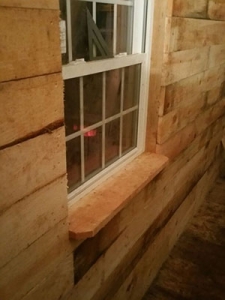 Early applications of knotty pine paneling included nailing up rough-sawn boards on wall framing. Although crude with air leaks between boards, it served as the entire walls. Eventually, narrow wood batten strips were nailed over the joints to hide the cracks and seal air leaks. Installing plain boards shows nail heads but few people minded seeing them.
Early applications of knotty pine paneling included nailing up rough-sawn boards on wall framing. Although crude with air leaks between boards, it served as the entire walls. Eventually, narrow wood batten strips were nailed over the joints to hide the cracks and seal air leaks. Installing plain boards shows nail heads but few people minded seeing them.
At some point, homeowners started nailing up wood batten strips on the insides of walls. This led to nailing up rough boards on the insides of wall framing that left empty spaces between the inside and outside walls with or without any type of insulation. As construction methods, materials, and home styles changed, knotty pine paneling became an inside wall covering. For people on low incomes, wood walls were not generally painted, stained, sealed, or finished.
Sanded Knotty Pine Paneling
As home styles changed and incomes increased, homeowners wanted a change in their wall and ceiling paneling. They wanted something more modern and stylish which led to smooth sanding the paneling. This presented a more refined appearance that needed less staining and finishing with a clear coat covering because rough-sawn boards soak up more finishing product.
Wood paneling for exterior walls gradually gave way to brick, stone, siding that looked like asphalt shingles, aluminum siding, vinyl siding, stucco, and other materials. With these changes, knotty pine paneling became an interior material except for garages, barns, and outbuildings. At this point in paneling’s evolution, it was available only in unfinished wood.
“Today’s best paneling product is tongue and groove with the end-matching design.”
4’ x 8’ Pine Paneling Sheets
As home décor evolved in the 1960s and 1970s, many homeowners started using 4’ x 8’ sheets of knotty pine paneling because they were less expensive, faster to install, and available pre-finished. This type of wall paneling served its purpose for thousands of homeowners including mobile homeowners. As years passed, homeowners grew tired of it for these reasons:
- It looked “cheap” compared to real wood paneling
- It was flimsy without additional wall framing for support
- Nail heads could be seen around the joints
- This paneling was easily damaged
- The butt joints could look unfinished
- Sheets of paneling went out of style
Tongue And Groove Pine Boards
During the wall paneling evolution, rough and smooth knotty pine paneling continued as a standard in log homes, log cottages, and other styles of cabins. It never went out of style for them while other homeowners switched to painted lath and plaster or drywall for their interior walls. For those homeowners who wanted knotty pine walls, tongue and groove became the norm and provided these benefits:
- T&G paneling hides nails and screws because they are placed in the grooves
- Tends to lay flatter without cupping or warping with weather changes
- Provides strong and stable walls and ceilings
- Easy to install by anyone with woodworking knowledge and skills
- Seamless look, less nailing, and available in a pre-finished condition
These photos show the natural beauty and charm of knotty pine paneling.
Tongue And Groove With End-Matching
![]() Although tongue and groove paneling was an advanced method of shaping boards, it had a few drawbacks. They include end-butting boards on wall framing, extra measuring, sawing, and nailing. Adding end-matching to the pine paneling revolutionized paneling construction and installation. End-matching consists of milling a tongue on one end and a groove on the other end of each piece of paneling that gives the advantages:
Although tongue and groove paneling was an advanced method of shaping boards, it had a few drawbacks. They include end-butting boards on wall framing, extra measuring, sawing, and nailing. Adding end-matching to the pine paneling revolutionized paneling construction and installation. End-matching consists of milling a tongue on one end and a groove on the other end of each piece of paneling that gives the advantages:
- Virtually creates a “no-waste” product that is environmentally friendly
- Locks the paneling together anywhere between the wall framing without nailing
- Avoids splicing and nailing two pieces together in the middle of framing studs
- Saves time and energy measuring, sawing, and nailing panels
- Available in unfinished and pre-finished condition
Knotty Pine Paneling Needs Trims And Molding
Installing knotty pine paneling is not complete without adding trims and moldings as finishing touches. You need them for full wall, wainscoting, or accent wall applications. Knotty pine trims and moldings are available in these favorite styles and shapes:
- Casing and Baseboard – Colonial, round-over, three bead
- Ceiling Trim – Beveled edge, triple bead, crown molding
- Corner Trim – Inside and outside corner trim
- Trim – Base shoe, cove, and quarter round
These trims are installed with a nail gun and the heads are covered with wood putty. All are available in an unfinished condition and many in a pre-finished condition.
Knotty pine paneling is a natural-looking and gorgeous material for walls and ceilings. Stain it and apply a clear coat finish or apply a clear coat finish only for a beautiful interior décor. For the best results, purchase tongue and groove paneling with the end-matching design.


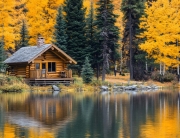
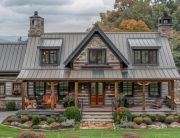
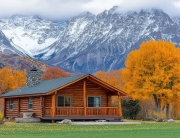
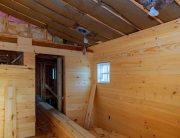
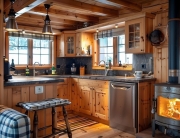
Recent Comments